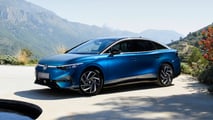
- Volkswagen will "probably" bring the ID.7 electric liftback to the United States next year.
- VW previously said it's indefinitely postponing the EV in the U.S. because the market is constantly changing.
The Volkswagen ID.7 liftback is an exceptional electric cruiser, as our own Editor-in-chief Patrick George found out after his brief stint with VW’s electric Arteon replacement in Europe earlier this year. “It’s a cushy, high-tech road trip champion with exceptional range,” Patrick said in his first drive review, which left us wondering: Why isn’t VW bringing the ID.7 to the United States?
It was supposed to debut stateside in the third quarter, but then the German automaker got cold feet and delayed the flagship EV due to changing “market dynamics” without providing provide a timeline of what would happen next. In other words, the unpredictable EV market put the brakes on the ID.7’s launch here. But that might soon change, and it all hinges on demand.
“We’re ready to launch the ID.7 as long as there’s consumer demand,” Volkswagen Group of America CEO Pablo Di Si said during Automotive News’ Daily Drive podcast last week. “We'll probably launch it next year. We haven't decided yet,” Di Si added.
Gallery: 2025 Volkswagen ID.7







So, would you buy a German-made electric liftback that’s roughly the size of a Tesla Model S, has a WLTP-rated driving range of 382 miles, an estimated starting price of $50,000, and will most likely not be eligible for the $7,500 federal tax credit when purchasing?
The cheapest Tesla Model S is $25,000 more expensive than the predicted starting price of the ID.7 in the United States and has an EPA rating of 402 miles on a full charge. It’s also all-wheel drive, whereas the base Volkswagen ID.7 with the 82-kilowatt-hour battery is rear-wheel drive (dual-motor all-wheel drive is also in the cards, but that will have an even lower driving range).
In Europe, VW has been selling the ID.7 for over a year–a story that's very similar to the ID. Buzz that finally came to the U.S. after about a two-year delay, albeit with a slightly disappointing range rating. That won't be the case with the ID.7 though, as even on the tougher EPA testing procedure, we expect it to offer at least 300 miles of range
The problem here is the waning demand for some sedans in the U.S., especially those powered by electricity. The sleek and spacious Hyundai Ioniq 6, for instance, which is slightly smaller than the ID.7, had its sales drop to just 599 units in September, while the Tesla Model S has long been relegated to the “Others Models” section on the automaker’s delivery charts which bundle the Model S, Model X and Cybertruck together.







